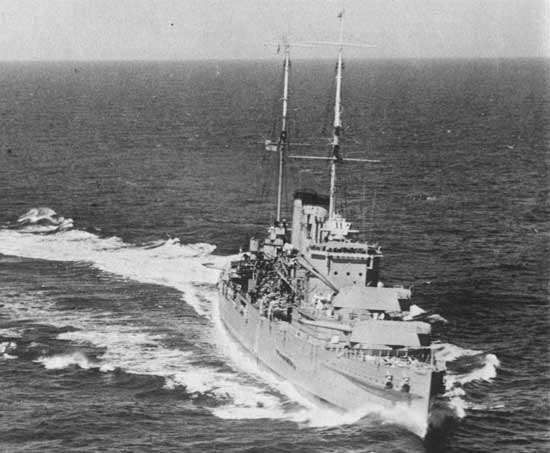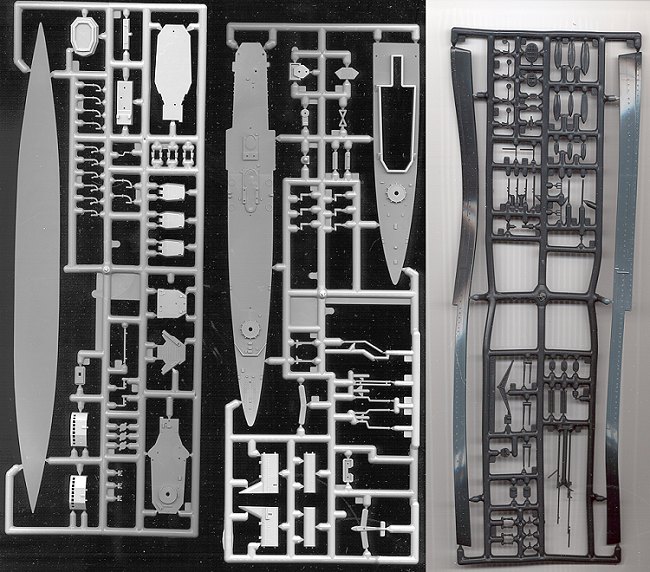
| KIT: | AMT 1/700 HMS Exeter |
| KIT # | 4405 |
| PRICE: | $? |
| DECALS: | Flag |
| REVIEW & | |
| NOTES: | This is a Matchbox kit |

| HISTORY |
 I was watching 'The Battle of the River Platte' the othernight on the TV and started thinking about the ships involved in themovie. The credits say that the original Ajax and Achilles were inthe flick, but not the Exeter. A bit of reading led to the discovery thatthe Exeter had been sunk in 1942 by the Japanese in the Battle of theJava Sea. Not very sporting of them to sink a famous ship like that!
I was watching 'The Battle of the River Platte' the othernight on the TV and started thinking about the ships involved in themovie. The credits say that the original Ajax and Achilles were inthe flick, but not the Exeter. A bit of reading led to the discovery thatthe Exeter had been sunk in 1942 by the Japanese in the Battle of theJava Sea. Not very sporting of them to sink a famous ship like that!
HMS Exeter was one of several 8" gun heavy cruisersbuilt after the first world war. Newer British cruisers of the mid-wars wentwith the lighter and faster-firing 6" guns, leaving the bigger guns on theolder ships. During the opening days of World War II, the Exeter was one of several ships sent down to the South Atlantic to find the Germanpocket battleship Graf Spee. After getting close to her, the force,consisting the cruisers Ajax, Achilles, and Exeter, spotted the GrafSpee heading for Montevideo, Uruguay for reprovisioning and to let offcaptives. A fierce gun battle ensued, damaging some of the British cruisers,including the Exeter, which basically lost the forward turret. TheBritish ships broke off to prevent thier total decimation as the Graf Speeheaded for South America. As you know, the British succeeded in fooling theGerman captain into thinking there was a large force of ships awaiting him ininternational waters so he scuttled the Graf Spee rather than lose her inbattle.
The Exeter was refit with removal of some older lightguns and the installation of more anti-aircraft weapons. This was done in 1941.Judging from the lack of these anti-aircraft guns on the kit, I would say thatthis kit is as she was during the battle with the Graf Spee.
| THE KIT |

Thinking that I still had a kit of this ship somewhere in thekit dungeon, I went down to take a peek. Sure enough, right there with the GrafSpee kit, also by AMT, was the Exeter. One can tell of the Matchboxheritage of this kit as it is molded in two colors, a dark green and a lightgrey, ostensibly to save me the chore of painting it! Due to the method ofmaking this a waterline (i.e. the old way without having a full-plan hull) itwas not unexpected that one hull half would be rather badly warped. A commonproblem with those skinny hull halves. What detail is there is all raised. Nodeck planks for this kit like on the Japanese ones. The partswere flash free with reasonable mold lines and few embarrassing ejector pinmarks.
The instructions are a pictorial representation in 16 steps. Theonly paint color information is on an overall view of the completed ship. Thecolors given are generic colors and written very small. I had to do a lot ofhunting to find it on the sheet. Overall, it looks like it will be more workthan with a Hasegawa or Aoshima 1/700 waterline ship, but it does look quitedo-able.
| CONSTRUCTION |
The first thing to do is to glue together the hull sides and the bottom. This ismade extremely difficult due to all the parts being rather badly warped. I hadto glue the three parts in small sections and used a lot of superglue to get itdone. Even in the end, the hull is slightly warped, though it shouldn't be too noticeableonce the kit is completed and on a decent base. Once the hull bits are together,the afterdeck was glued in place. This also was a rather difficult thing to do,again, thanks to the warpage.
| PAINT & DECALS |
| CONSTRUCTION CONTINUES |
| CONCLUSIONS |
| REFERENCES |
Review copy courtesy of me and my wallet! If you would like yourproduct reviewed fairly and quickly by a site that has over 800 visits a day,please contact me or see other details inthe Note toContributors.